Tackling black mold in your home can be quite tedious, especially if the mold leaves behind unsightly black stains on whatever surface it was inhabiting. That’s why we’re here to help!
This article will provide you with some information about what black mold stains are and how they can affect your health and home. It also covers some helpful tips on how to remove these stains from a range of different surfaces and materials.
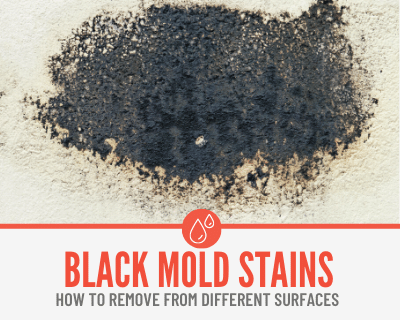
Does Black Mold Stain?
In short, yes, black mold can and will stain the surface it was growing on if the infestation isn’t dealt with quickly and properly.
Lightly-colored surfaces like white clothes and walls are at the highest risk of having visible stains but pretty much any surface can have them, even if they’re not visible.
How Do Black Mold Stains Form?
Black mold stains form when an infestation of black mold has been present on a surface for an extended period of time.
Just like with any other type of mold, black mold begins growing when the environment consistently warm and wet, with no proper airflow.
Black Mold Damage?
Call 844-488-0570 for a Risk Free estimate from a Licensed Mold Remediation Specialist in your area.
We Can Help Remove Black Mold, Black Mold Stains & Deal with The Root cause of the black mold.
Are Black Mold Stains Dangerous?
Health Risks
The health risks associated with black mold exposure can be quite severe, including headaches, constant fatigue, and chronic respiratory issues.
Thankfully, most black mold stains won’t contain any mold spores, meaning that the stains themselves will not affect your health negatively.
However, it’s always better to be safe than sorry – some black mold growths can be minuscule and easily masked by already-existing stains, potentially leading to worse health complications in the future.
Damage To Your Property
While black mold stains don’t necessarily impact the structural integrity of your home, they do impact its appearance. Nobody wants unsightly stains all over their walls or clothes, especially since black mold tends to stain quite dark – it makes everything look dirty!
Not only do black mold stains make your environment ugly and unpleasant to live in, but they can also actually lower the property value of your home, so keep that in mind if you’re thinking about selling it.
What About Dry Black Mold Stains?
Dry black mold stains behave just like other black mold stains – while they’re not harmful to your health, they do ruin the aesthetic of your home.
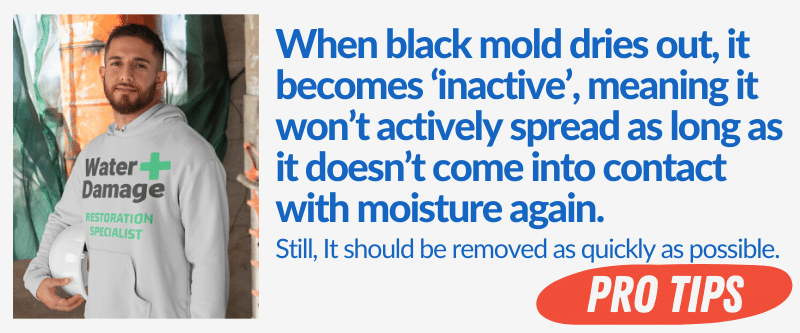
How To Remove Black Mold Stains
The method you should use to remove black mold stains varies largely depending on what the stained item or material is, and how extensive the staining is. Below, we take a look at some of the best mold stain removal techniques.
Whatever you do, NEVER mix bleach with vinegar when tackling black mold stains – while both individually are great cleaning products, they create deadly chlorine gas when combined.
Removing Black Mold Stains From Fabric
Depending on how fresh or old the black mold stains are on the fabric, you may need to use stronger chemicals or spend a lot longer on the cleaning process
Just like with any other stains from foods or drinks, you should be able to get rid of them with the correct cleaning supplies. However, there is always a slim chance of a stain becoming permanent.
For example, very delicate fabrics such as silk are notoriously difficult to clean, and may still retain some discoloration even after treatment.
If anything, using chemicals that are too harsh for the fabric you’re cleaning may cause more damage than the mold stains themselves, so be cautious!
What kind of damage can the Black mold stains cause?
The worst thing that black mold stains can do to your fabrics is to make them look dirty and smell a bit musty.
There shouldn’t be any physical damage such as holes or tears unless the fabric was damaged while cleaning off the mold itself.
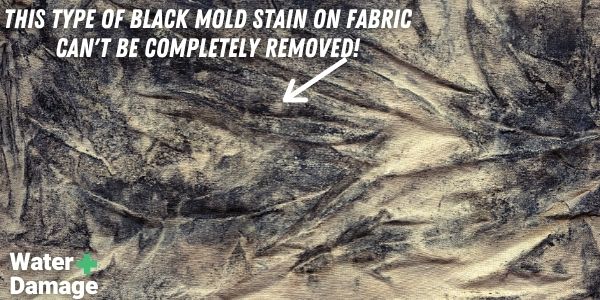
So, how do you get rid of them?
- First of all, make sure that any black mold that was growing on the fabric is removed. You can do that by applying some vinegar and letting it sit for 60, then rinsing and scrubbing the fabric thoroughly.
- If you can get your hands on mold stain remover, apply that directly onto the fabric then scrub it with a toothbrush – make sure to be very careful, you don’t want to damage the fabric!
- Alternatively, use a mixture of hydrogen peroxide and water to saturate the stains, then scrub and rinse.
- Make sure to only use hydrogen peroxide on organic fabrics like cotton or linen.
Continue Reading: How to Kill Black Mold with Hydrogen Peroxide
Removing Black Mold Stains From Carpet
Most of the time, black mold stains should be possible to remove completely from your carpet. The ease of removal will, however, depend on the type of carpet you have.
Thick, fuzzy carpets, for instance, may need more time and product to clean completely.
Just like with fabrics, the black mold stains on your carpet shouldn’t cause any physical damage. They will simply make the carpet look very unsightly and will probably make it smell unpleasant.
Again, the actual removal of the stains may prove more damaging if you use harsh chemicals or scrub too hard.
However, if the carpet is very light in color or the stain is very old (think months or even years), some discoloration may remain forever.
So, how do you get rid of them?
- As with fabrics, you need to make sure that any black mold growth is removed first. Try vacuuming the carpet first to remove any loose spores, then treat it with vinegar.
- If the carpet is small enough and can be moved, we suggest using either your bathtub or washing machine to tackle the mold stains.
- Mix about half a cup of borax (or sodium carbonate mixed with sodium bicarbonate if you’re looking for a substitute) with hot water, and either add directly to the washing machine drum or pour it into the bathtub, submerging the carpet in it.
- If the carpet is too big or can’t be moved, we recommend saturating the area with mold stain remover or vinegar, then scrubbing with a brush.
Removing Black Mold Stains From Clothes
You should be able to successfully remove black mold stains from most clothes. As mentioned above, some fabrics may be too delicate for the cleaning process but that is quite rare.
Unless the stains are very old or the garment is too delicate for the cleaning process, you should be able to completely remove black mold stains with no discoloration remaining.
What kind of damage can the stains cause?
A majority of the damage caused by black mold stains will be cosmetic – your clothes will have ugly black and grey patches, but will otherwise be untouched.
Some very delicate articles of clothing may end up with small holes, though this is caused by the black mold growth and not the stains it leaves behind.
So, how do you get rid of them?
- If there is still any mold left on the clothing, or if the stains are quite old, you should pre-soak the items in a solution of vinegar and water or mold stain remover for up to an hour.
- Adding a borax and water solution to the drum of your washing machine and washing the clothes on whatever cycle you use normally use should normally do the trick.
- You may need to wash the clothes multiple times, depending on how large and intense the stains are.
What about white clothes?
Since white clothes are super easy to stain, you may need to use harsher chemicals to get rid of black mold stains.
We recommend adding bleach to your wash cycle if you’re cleaning white clothes – just make sure to NEVER use vinegar as your pre-soak solution.
Black Mold Can Cause Serious Health Issues
Call 844-488-0570 for a Risk Free estimate from a Licensed Black Mold Remediation Specialist in your area.
We Can Help you Get Rid of the Black Mold & Prevent it from Returning!
Removing Black Mold Stains From Wood
Removing black mold stains from wood can be a little tricky, as wood is a porous material, but it can be achieved with the right approach!
As with other materials, lighter-colored wood will be more susceptible to staining and may require some more effort to clean than darker wood.
You should be able to completely remove black mold stains from wood, but even if some discoloration remains, not all is lost!
You can always use some wood paint or varnish to cover up any remaining dark spots.
What kind of damage can the stains cause?
The stains themselves can cause substantial aesthetic damage, especially if the wood is light and the black mold was present for an extended period of time.
Apart from that, there shouldn’t be any physical damage, unless the mold itself ate away at the wood.
So, how do you get rid of them?
- Your first step is to make sure any remaining black mold is cleaned off the wood, especially if the surface has any crevices. Use a dry paintbrush to do this.
- Using a solution of bleach and cool water (hot water can warp wood easily) to scrub the affected area. We suggest performing a patch test somewhere on the surface to ensure the bleach won’t discolor the wood.
- If you’d rather use something milder, scrubbing the area with vinegar should do the trick.
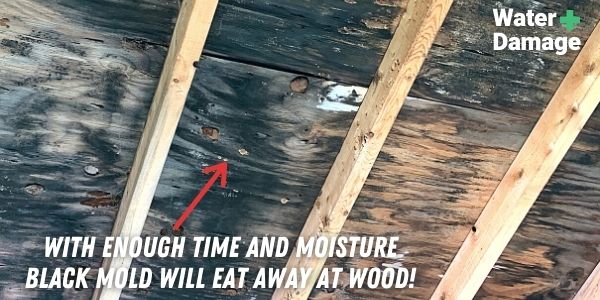
Removing Black Mold Stains From Grout
It’s actually very easy to remove black mold stains from grout, even if it’s a bright white color.
Black mold stains can be completely removed from grout, and you’ll be surprised just how easily the stains come off!
Most grout is treated with a sealant after being applied, making it not very porous and therefore incredibly easy to clean.
What kind of damage can the stains cause?
Black mold stains shouldn’t cause any physical damage or degradation to grout – if they seem to, there’s probably still mold growing there! They will, however, make the grout look much darker and dirtier than it really is.
So, how do you get rid of them?
- As always, you need to first make sure that there is no more mold left on the grout before attempting to clean it. As mentioned before, most grout gets treated with a sealant, so there probably won’t be any loose spores hiding anywhere.
- To tackle the stains, saturate the affected area with vinegar, ideally using a spray bottle to do so. Let that sit for about 30 minutes, then scrub it with a toothbrush – be very careful to not chip away at the grout!
- Depending on how severe the stains are, you may need to spray the area down and scrub it more than once.
Removing Black Mold Stains From Rubber
Just like grout, rubber is surprisingly easy to clean, even if it has tough black mold stains. Its slippery surface makes scrubbing it clean a very simple process.
Black mold stains should come off rubber completely with very little effort. Even light-colored rubber usually doesn’t have any discoloration left behind.
What kind of damage can the stains cause?
Black mold stains will thankfully only cause cosmetic damage, meaning that the integrity of the rubber will not be affected.
However, black and gray spots all over the surface are incredibly unsightly and should be treated as soon as possible.
So, how do you get rid of them?
- The best way to remove black mold stains from rubber is to saturate the area with vinegar – bleach may be too harsh and cause discoloration.
- Use a spray bottle to douse the whole area, let the vinegar sit for about 30 minutes, then scrub it clean with a toothbrush.

Removing Black Mold Stains From Plastic
Most of the time, black mold stains can be removed from plastic. Removing black mold stains from plastic can be a little difficult, depending on what item is affected.
For example, plastic containers are easy to clean as they can be soaked and scrubbed.
They can be a bit persistent if there’s any damage on the plastic, like scratches, as they really cling to crevices like that, so make sure to scrub well!
What kind of damage can the stains cause?
These stains will leave your plastic looking dirty and smelling foul, so it’s important to clean them as quickly as possible.
There shouldn’t be any physical damage to the plastic unless it happened when the black mold was still present.
So, how do you get rid of them?
- If you’re looking to clean something like plastic containers, we recommend filling up your sink with warm water and bleach, letting them soak for 30 to 60 minutes, then giving them a good scrub.
- Remember to wear gloves while doing this, as bleach can irritate your skin!
Removing Black Mold Stains From The Shower
The bathroom is one of the most common places to find black mold due to the constant moisture and high temperatures, but thankfully black mold stains can be removed from the shower with ease.
In theory, these stains can be permanently removed from the shower.
However, since the environment is so moist and wet, you will have to constantly monitor the affected area to ensure the stains don’t return.
What kind of damage can the stains cause?
The worst thing the black mold stains will do to your shower is to make it look dirty and smell bad – any physical damage will be from the mold growth, but even that is unlikely.
So, how do you get rid of them?
- Hydrogen peroxide mixed with water is your best friend when it comes to removing black mold stains from the shower. Fill a spray bottle with the solution, saturate the area, and scrub with a toothbrush.
- To prevent any future mold growth, you can regularly spray the shower down with some vinegar – just make sure to let it air out!
Removing Black Mold Stains From Concrete
Removing black mold stains from concrete can prove quite difficult – concrete can be porous so loose spores and stains will cling to it.
With enough patience and scrubbing, you should be able to remove the majority of the stains, but some discoloration may remain.
What kind of damage can the stains cause?
The cosmetic damage caused by black mold stains usually won’t be super noticeable, since concrete is normally quite dark in color. Despite that, it’s still in your best interest to try and get rid of these stains as quickly as possible.
So, how do you get rid of them?
- If the affected concrete is outside, you can just grab a hose and rinse the affected area with a lot of water to ensure that any spare spores get flushed out. If the area is inside, consider using a spray bottle to do the same thing.
- Once any loose spores are gone, use a solution of bleach and water to saturate the mold stains, letting it sit for at least 30 minutes. Then take a hard bristled brush and scrub until clean – you may need to repeat this step a few times to get it fully clean.
Removing Black Mold Stains From Walls
Walls are another area that suffers from black mold stains quite often, but thankfully they’re relatively easy to clean.
It does depend on what kind of wall is affected – different types of paint and wallpaper may make the stains cling on a bit more than others.
It’s usually possible to completely remove black mold stains from painted walls, but wallpapered walls might prove to be much trickier – some wallpaper may even stain permanently and simply need replacing.
What kind of damage can the stains cause?
Black mold stains will cause your walls to look very unsightly – they’ll be covered in black and grey patches that look like dirt. They may also cause your home to constantly smell like mold, which is incredibly unpleasant.
So, how do you get rid of them?
- A solution of vinegar and water should be able to get rid of black mold stains on your walls. Spray it onto the affected area and scrub it with a sponge or soft brush to prevent the paint from chipping or wallpaper from peeling off.
- If the stains are quite substantial, you can try using a bleach and water solution instead. Just make sure to NEVER use both vinegar and bleach on the same area.
- Since you’ll almost certainly be working indoors, make sure that all of the windows and doors are open while you do this to prevent inhalation of dangerous chemicals.
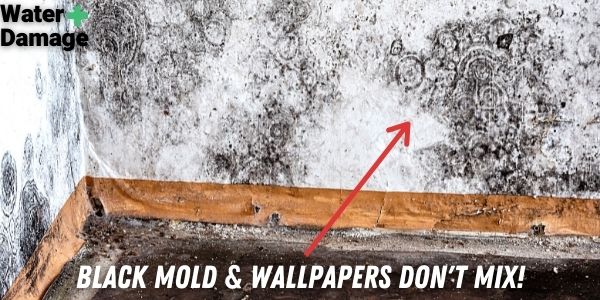
Removing Black Mold Stains From The Ceiling
You should be able to completely remove black mold stains from your ceiling.
The biggest issue with removing black mold stains from the ceiling will be actually getting up there and reaching the stains! Apart from that, you should be able to remove them quite easily.
Your ceiling probably won’t have any wallpaper on it like your walls might, so you don’t have to worry about the stains becoming permanent.
What kind of damage can the stains cause?
Just like with walls, the stains will cause some pretty ugly patches all over the ceiling, which may eventually spread down the walls if not dealt with promptly.
So, how do you get rid of them?
- First, find a way to get up to the affected area of your ceiling. We recommend some sort of step ladder or table, just please make sure to stay safe!
- With a spray bottle, try your best to saturate the area with vinegar. Again, be extremely careful with this step, you don’t want vinegar dripping down onto your face while you work!
- Once saturated, give the area a good scrub with a sponge or soft brush, and repeat as needed.
How Can I Prevent Black Mold Stains?
The simplest way of preventing black mold stains is to ensure your home doesn’t provide a good environment for mold growth. Keeping each room well ventilated and investing in some dehumidifiers is very important.
Getting rid of black mold as soon as you notice it is another great prevention method. Remember: black mold needs to be present on a surface for a while before it begins to stain, so make sure to remove it quickly!
Don’t worry if you were unable to prevent black mold stains from forming – that’s what this article is for!
When To Call A Professional
Black mold stains are easy enough to remove by yourself since they can be cleaned with household products like bleach or vinegar. However, if the staining is very extensive (i.e. covering a large surface area) or if you’re dealing with a large-scale infestation, we would recommend calling a professional.
We have Mold Removal and Remediation Technicians that can help Remove Black Mold & Prevent it from returning.
For Disasters of all Sizes,available in 95% of USA
